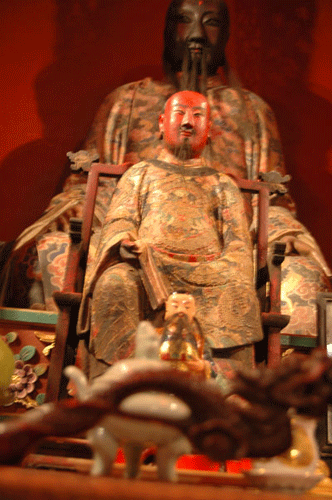
Categorization
There is debate over how, and whether, Taoism should be subdivided. Livia Kohn divided it into the following three categories:
1) “Philosophical Taoism” (Daojia 道家) – A philosophical school based on the texts Dao De Jing (道德經) and Zhuangzi (莊子);
2) “Religious Taoism” (Daojiao 道敎) – A family of organized Chinese religious movements originating from the Celestial Masters movement during the late Han Dynasty and later including the “Orthodox” (Zhengyi 正一) and “Complete Reality” (Quanzhen 全眞) sects, which claim lineages going back to Lao Zi (老子) or Zhang Daoling in the late Han Dynasty;
3) “Folk Taoism” – The Chinese folk religion.
This distinction is complicated by hermeneutic (interpretive) difficulties in the categorization of Taoist schools, sects and movements. Some scholars believe that there is no distinction between Daojia and Daojiao. According to Kirkland, “most scholars who have seriously studied Taoism, both in Asia and the West, have finally abandoned the simplistic dichotomy of Tao-chia and Tao-chiao, ‘philosophical Taoism’ and ‘religious Taoism.'”
Hansen states that the identification of “Taoism” as such first occurred in the early Han Dynasty when dao-jia was identified as a single school. The writings of Laozi and Zhuangzi were linked together under this single tradition during the Han Dynasty, but notably not before. It is unlikely that Zhuangzi was familiar with the text of the Daodejing. Additionally, Graham states that Zhuangzi would not have identified himself as a Taoist, a classification that did not arise until well after his death.
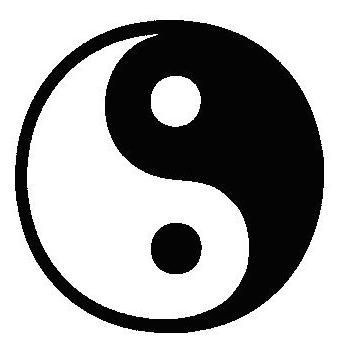
Taoism does not fall strictly under an umbrella or a definition of an organized religion like the Abrahamic traditions, nor can it purely be studied as the originator or a variant of Chinese folk religion, as much of the traditional religion is outside of the tenets and core teachings of Taoism.Robinet asserts that Taoism is better understood as a way of life than as a religion, and that its adherents do not approach or view Taoism the way non-Taoist historians have done. Henri Maspero noted that many scholarly works frame Taoism as a school of thought focused on the quest for immortality.
Beliefs
Taoism has never been a unified religion, but has rather consisted of numerous teachings based on various revelations. Therefore, different branches of Taoism often have very distinct beliefs. Nevertheless, there are certain core beliefs that nearly all the sects share.
Principles
Taoist theology emphasizes various themes found in the Daodejing and Zhuangzi, such as naturalness, vitality, peace, “non-action” (wu wei, or ‘effortless effort’), emptiness (refinement), detachment, flexibility, receptiveness, spontaneity, the relativism of human ways of life, ways of speaking and guiding behavior.
Spirituality
Taoists believe that man is a microcosm for the universe. The body ties directly into the Chinese five elements. The five organs correlate with the five elements, the five directions and the seasons. Akin to the Hermetic maxim of “as above, so below”, Taoism posits that man may gain knowledge of the universe by understanding himself.
In Taoism, even beyond Chinese folk religion, various rituals, exercises, and substances are said to positively affect one’s physical and mental health. They are also intended to align oneself spiritually with cosmic forces, or enable ecstatic spiritual journeys. These concepts seem basic to Taoism in its elite forms. Internal alchemy and various spiritual practices are used by some Taoists to improve health and extend life, theoretically even to the point of physical immortality.
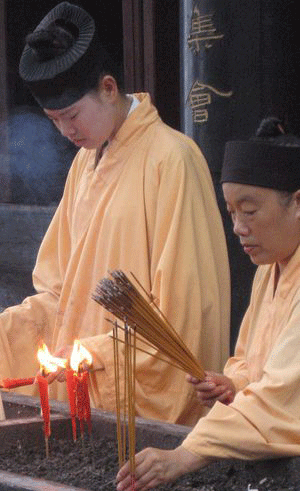
History
Some forms of Taoism may be traced to prehistoric folk religions in China that later coalesced into a Taoist tradition. Laozi is traditionally regarded as the founder of Taoism and is closely associated in this context with “original”, or “primordial”, Taoism. Laozi received imperial recognition as a divinity in the mid second century B.C.E. Taoism gained official status in China during the Tang Dynasty, whose emperors claimed Laozi as their relative. Several Song emperors, most notably Huizong, were active in promoting Taoism, collecting Taoist texts and publishing editions of the Daozang. Aspects of Confucianism, Taoism, and Buddhism were consciously synthesized in the Neo-Confucian school, which eventually became Imperial orthodoxy for state bureaucratic purposes. The Qing Dynasty, however, much favored Confucian classics and rejected Taoist works. During the eighteenth century, the imperial library was constituted, but excluded virtually all Taoist books. By the beginning of the twentieth century, Taoism had fallen so much from favor, that only one complete copy of the Daozang still remained, at the White Cloud Monastery in Beijing. Taoism is one of five religions recognised by the PRC, and regulates its activities through a state bureaucracy (the China Taoist Association).
Adherents
The number of Taoists is difficult to estimate, due to a variety of factors including defining Taoism. The number of people practicing Chinese folk religion is estimated to be just under four hundred million.[79] Most Chinese people and many others have been influenced in some way by Taoist tradition. Estimates for the number of Taoists worldwide range from twenty to over fifty million.
Taoism as with other religions in China have been oppressed and discouraged during the Cultural Revolution, thus the number of Taoists today greatly declined from the pre-Communist China.
Recently, there have been some efforts to revive the practice of Taoist religion. In 1956, the Chinese Taoist Association was formed, and received official approval in 1957. It was disbanded during the Cultural Revolution under Mao, but reestablished in 1980. The headquarters of the Association are at Baiyun guan, or White Cloud Temple, of the Longmen branch of Quanzhen.
Geographically, Taoism flourishes best in regions populated by Chinese people: mainland China, Taiwan, Malaysia, Singapore, and various Chinese diaspora communities. Taoist literature and art has influenced the cultures of Korea, Japan, and Vietnam. Organized Taoism seems not to have attracted a large non-Chinese following, except in Korea (e.g. see Kouk Sun Do) and Vietnam, until modern times. In Taiwan 7.5 million people (33% of the population) identify themselves as Taoists. In Singapore, 8.5% of the population identify themselves as Taoist. There are also small numbers of Taoists in the Western world.
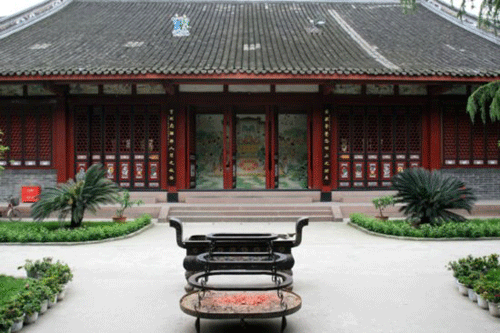
Practices
At certain dates, food may be set out as a sacrifice to the spirits of the deceased and/or the gods, such as during the Qingming Festival. This may include slaughtered animals, such as pigs and ducks, or fruit. Another form of sacrifice involves the burning of Joss paper, or Hell Bank Notes, on the assumption that images thus consumed by the fire will reappear—not as a mere image, but as the actual item—in the spirit world, making them available for revered ancestors and departed loved ones. At other points, a vegan diet or full fast may be observed.
Also on particular holidays, street parades take place. These are lively affairs which invariably involve firecrackers and flower-covered floats broadcasting traditional music. They also variously include lion dances and dragon dances; human-occupied puppets (often of the “Seventh Lord” and “Eighth Lord”); tongji (童乩 “spirit-medium; shaman”) who cut their skin with knives; Bajiajiang, which are Kungfu-practicing honor guards in demonic makeup; and palanquins carrying god-images. The various participants are not considered performers, but rather possessed by the gods and spirits in question.
Fortune-telling—including astrology, I Ching, and other forms of divination—has long been considered a traditional Taoist pursuit. Mediumship is also widely encountered in some sects. There is an academic and social distinction between martial forms of mediumship (such as tongji) and the spirit-writing that is typically practiced through planchette writing.
Many Taoists also participate in the study, analysis and writing of books. Taoists of this type tend to be civil servants, elderly retirees, or in modern times, university faculty. While there is considerable overlap with religious Taoism, there are often important divergences in interpretation. For example, Wang Bi, one of the most influential philosophical commentators on the Laozi (and Yijing), was a Confucian.
A number of martial arts traditions, particularly T’ai Chi Ch’uan, Bagua Zhang, Wing Chun, Won Yuen Yat Hey Jueng, Bak Mei Pai, Bok Fou Pai, Yaw Gong Moon and Xing Yi Quan, embody Taoist principles to a greater or lesser extent, and some practitioners consider their art to be a means of practicing Taoism.
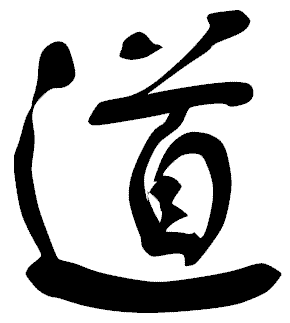
Relations with other religions and philosophies
The terms Tao and De are religious and philosophical terms shared between Taoism and Confucianism. The authorship of the Tao Te Ching is assigned to Laozi, who is traditionally held to have been a teacher of Confucius. However, some scholars believe the Tao Te Ching arose as a reaction to Confucianism. Zhuangzi, reacting to the Confucian-Mohist ethical disputes in his “history of thought”, casts Laozi as a prior step to the Mohists by name and the Confucians by implication.
Early Taoist texts reject the basic assumptions of Confucianism which relied on rituals and order, in favour of the examples of “wild” nature and individualism. Historical Taoists challenged conventional morality, while Confucians considered society debased and in need of strong ethical guidance.
The entry of Buddhism into China was marked by interaction and syncretism, with Taoism in particular. Originally seen as a kind of “foreign Taoism”, Buddhism’s scriptures were translated into Chinese using the Taoist vocabulary. Chan Buddhism was particularly modified by Taoism, integrating distrust of scripture, text and even language, as well as the Taoist views of embracing “this life”, dedicated practice and the “every-moment”. Taoism incorporated Buddhist elements during the Tang period, such as monasteries, vegetarianism, prohibition of alcohol, the doctrine of emptiness, and collecting scripture in tripartite organisation. During the same time, Chan Buddhism grew to become the largest sect in Chinese Buddhism. Christine Mollier concluded that a number of Buddhist sutras found in medieval East Asia and Central Asia adopted many materials from earlier Taoist scriptures.
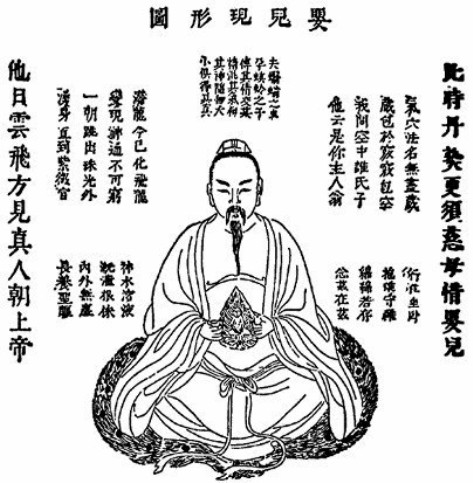
Ideological and political rivals for centuries, Taoism, Confucianism, and Buddhism deeply influenced one another.[105] They also share some similar values, with all three embracing a humanist philosophy emphasizing moral behavior and human perfection. In time, most Chinese people identified to some extent with all three traditions simultaneously.[106] This became institutionalised when aspects of the three schools were synthesised in the Neo-Confucian school.
The extent, or not, of Taoist influence on Western philosophy is controversial, but some scholars see Heraclitus, with his distinctive philosophy of ‘change’ as reflecting the influence of Taoism, and there is even a small group of scholars who see Taoist influence in the philosophy of Plato and Socrates.[108]. Hegel and Schopenhauer both wrote of Taoism.
Source : http://www.wikipedia.org




